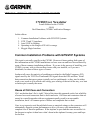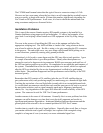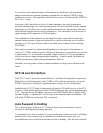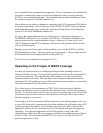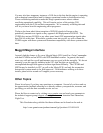The CNX80 install manual states that the typical loss at a connector crimp is 0.2 db.
However we have seen many where the loss due to an old crimp that has worked loose or
was poor quality to begin with can be 10 times this number, significantly degrading the
Nav/Comm or GPS performance. In all cases, it is best to check the antenna and coax
using an antenna analyzer as discussed below.
Installation Problems
This is one of the reasons Garmin requires IFR capable systems to be installed by a
Garmin distributor using proper tools and techniques. To offer a bad example, a few
years back I was helping a friend install new GPS equipment in his Sky King vintage
310.
We were in the process of installing the GPS coax to the antenna and lacked the
appropriate crimping tool. The A&P told him to “make it flat” using whatever device
was at hand to achieve the goal. He did so using a vise grip, mangling the $25 connector
in the process. The end result was a very poor crimp with ground shield poking out in
several directions, potentially causing stray ground problems.
Miraculously it did work to some degree and the GPS was able to track position. I gave
it a couple of months before it gave him problems. Shortly after the airplane was
returned to service he began receiving numerous RAIM error messages and total loss of
the GPS navigation position on occasion. He complained to me about the performance of
the system. I reminded him of the less than acceptable coax install, which was replaced
after the GPS was checked by the service department and verified to be performing
within limits. The problem disappeared and the performance and reliability of the GPS
increased greatly.
Remember that GPS consists of 24 satellites (plus the two WAAS satellites that are
geosynchronous orbit) each producing roughly as much energy as a household light bulb.
Tracking the equivalent of several light bulbs in earth orbit is not a straightforward task.
As a result there are numerous criteria that each satellite must pass to be used as a part of
the navigation solution, such as signal strength, mask angle, frequency interference
checks, etc. Any degradation of the signal will affect the overall reliability of the GPS
system. The same can be said for VHF Nav/Comm performance.
Another concern is the reuse of old antennas. Generally this is a rarer problem, but older
antennas can suffer damage over time that is not physically apparent and results in
significant performance degradation. Inadequate bonding between the antenna and the
ground plane of the aircraft is also a common problem for VHF Nav/Comms.
Another item to watch is the use of signal splitters. Generally these work fine, so long as
you remain within the total signal loss budget, but a splitter with a marginal crimp
coupled to a long run of coax (even new) can cause substantial signal loss.



